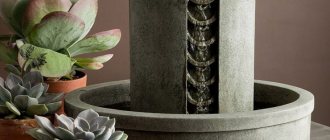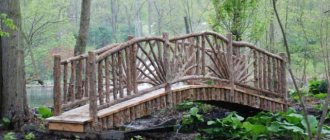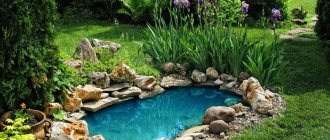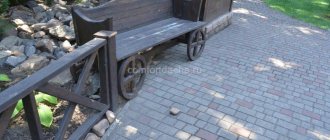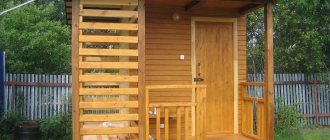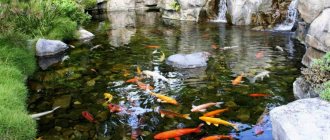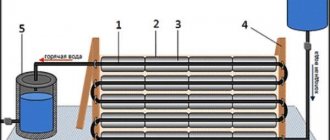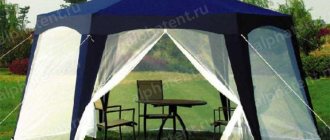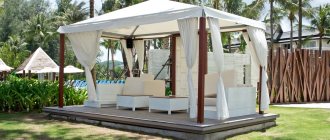A nice fountain for a pond in a country house has long ceased to be a curiosity and is often an integral element of landscape design. The reason for its popularity lies in the life-giving energy of water flows and the high decorative component of the object. The opinion that installing a fountain in a dacha is accessible only to a narrow segment of society due to its high cost is erroneous; the variety of shapes and sizes makes it possible to decorate the site with a budget copy. A self-made fountain can reduce costs when arranging landscape design.
Do-it-yourself fountains for garden ponds in the country (with photos)
A fountain for a garden pond will not just be a decoration, but also an optimal means of humidifying the air during the hot summer months. Even a miniature fountain will be your favorite place to relax, where you can completely relax and enjoy unity with nature.
All this will not be difficult if you know how to make a fountain in a pond and have a clear example of the step-by-step construction of a specific model.
It is believed that the greatest effect from the operation of fountains is achieved in reservoirs of regular shape, where they are placed in the center so that the jets of water they emit do not fall on coastal plants. In a large reservoir, you can install a fountain on the side, and if the reservoir is small, then the fountain can be made miniature.
Pay attention to the photo - a fountain in a pond can be given a special look using special nozzles that are installed on an underwater pump:
This system also sets the height of the jet ejection. Using nozzles, you can make a stream of water in the form of a bell or a beating spring.
The body of a fountain for an artificial pond can be installed either on the bottom of a reservoir or on a special stand. The fountain itself and its boring tube are best decorated with fiberglass, stone, bronze or ceramic cladding.
There are many design methods: you can arrange the fountain in a classic, rustic, oriental or avant-garde style. In any case, this design will be a striking addition to the landscape design of a summer cottage.
Fountains are usually used to create decorative ponds, but everything will depend on the shape of the fountain and its design. For classic reservoirs with regular shapes, classic fountains that shoot out with a dome-shaped stream are also needed. And fountains for a decorative pond with a free coastline can be decorated with an exotic frame and a free supply of water in the form of a regular stream.
Types of decorative ponds with a fountain
Solar powered
An obstacle to installing a fountain is sometimes the lack of adequate power supply on the land or the difficulty of connecting cables to the reservoir. This obstacle can be overcome by installing a heliofountain . An autonomous solar-powered fountain for garden ponds can be installed in any sunny location. Its design includes a solar panel, a pressure pump, pipelines and the fountain itself.
To ensure safety, a low-voltage pump is used. The equipment of expensive models is complemented by a battery, which is designed to ensure the operation of the fountain in cloudy weather and at night. The controller allows you to monitor the battery charge. During the day, the device is charged using solar energy. In addition to the pump, LED lighting can also be powered from the battery at night, giving the jets a special charm.
Floating
Floating fountains for decorative ponds have the same capabilities as regular ones. Such a device includes a submersible pump, which is mounted on a plastic float . The jet is shaped by special nozzles. More expensive models can cyclically change the shape of the jet(s), their height and power, and illuminate them.
Installation of a floating fountain does not require complex land construction work on the road section. You just need to find a safe and reliable way to connect it to electricity. From this point of view, it is best to purchase a floating heliofountain.
Among other advantages, a floating fountain saturates the water with oxygen , which stimulates the vital activity of organisms living in the pond. By changing the location of the water intake with an extension, you can also achieve regular mixing of the bottom water layers in order to avoid their siltation.
Photo of illuminated pond fountains.
Backlit
Illumination of a pond with a fountain will amazingly transform the evening garden and give it a unique charm . It uses a variety of lamps and reflectors that focus light. They can illuminate a large area or, conversely, highlight individual elements.
The use of a step-down transformer allows you to connect up to ten low-voltage lamps of varying power to the network simultaneously. An exceptional effect is achieved by combining above-ground lamps with lamps shining from under the water. The colorful color scheme is created by a combination of red, yellow, and blue lamps.
With filter
Combining a fountain with a filter for purifying water in a pond in one device allows you to combine aesthetics with the useful functionality of the device. In a pond with such a fountain, the breeding of healthy fish and ornamental plants will be ensured.
Filters are capable of disinfecting water, ridding it of harmful microorganisms and saturating it with beneficial bacteria. The most advanced devices of this type combine various types of mechanical and chemical filters with ultraviolet irradiation of water.
It is best to purchase a factory product of this type: it will provide for all the nuances that arise when using the device.
Fountain color therapy
Fountain lighting is an additional function, but very interesting and useful. The light accompaniment of the movement of water jets not only dispels the darkness, but has an emotional impact. Static lighting is good when the water seems filled with light, but dynamic lighting, in which the light also becomes alive and plays with the moving water, gives an indescribable experience.
And finally, about one more feature of fountains - they are able to change the energy of the environment, cleansing it of negative deposits. You can talk a lot about the influence of the element of water in the spirit of Eastern philosophy, or you can simply recognize a fountain in the garden as a necessity.
| Leave your review |
| I am not a robot. |
| Send Reset |
Leave your review
Average rating: 0 reviews
Features of country fountains
An artificial fountain is a unique structure that brings you closer to nature and gives you a special microclimate. At the same time, a pond is an element of site decoration that has a beneficial effect on a person’s mood and physical health. The movement of water calms, allows you to escape from problems and bustle, restoring the nervous system. In order for the fountain to bring joy and not trouble, it is important to wisely choose the design and materials, location and size of the reservoir. A country fountain is a relatively simple, but no less attractive design that you can make with your own hands.
Choosing a pump for a home fountain with your own hands
The pump is the main mechanism of the fountain, which ensures the continuous movement of water in the reservoir. The principle of its operation is as follows. Water is taken by a pump, on the suction pipeline of which a filter is installed, where coarse and fine cleaning of the liquid is carried out, and is thrown into the tank through nozzles.
When choosing a pump for a fountain, it is necessary to take into account the operating voltage, productivity, height of water rise and power of the unit. It is better to give preference to models equipped with various hoses, nozzles and spray heads, since purchasing additional elements will be extremely problematic if necessary.
For the fountain, two types of pumping units are used: piston and surface. The first option is installed at the bottom of the tank and works on the principle of a centrifuge. It is represented by a small, low-power, inexpensive device that is suitable for small fountains. The unit operates silently and consumes little electricity.
Two types of pumps are suitable for fountains: surface and piston
For more complex multi-level designs (in the form of DIY home waterfalls), you should use a surface type of pumping equipment. It is installed in close proximity to the tank and must be reliably protected from exposure to precipitation and direct sunlight. To do this, it can be covered with a special protective casing or placed in a pavilion or box. The pump is quite noisy and is characterized by high cost. However, this is a reliable and durable type of unit that can last for many years without additional maintenance.
Additional equipment for creating a DIY fountain house
Thanks to various sprayers, nozzles, and water flow regulators, you can create unusual visual effects by changing the shape and adjusting the intensity of the jet, which can be smooth, intermittent, high or low. Due to the use of different types of sprayers, the fountain can move around its axis and release bubbles of different shapes from under the water.
Single sprayers throw small vertical jets of water to a certain height, tiered sprayers - to different heights, forming several layers. The geyser nozzle provides a large amount of soap bubbles. A continuous cascading wall of water can be created using a fishtail sprayer.
Decorative lighting from a home fountain will help make the place truly magical. To do this, you can use moisture-resistant spotlights. With the help of multi-colored LED strips that are laid around the perimeter of the fountain, the contours of the tank are favorably emphasized. You can install solar panels along the shore of the pond, which accumulate energy during the day, and in the evening they spend it on waterproof lamps. It is recommended to provide soft, diffused light by using diode lamps.
Additionally, you can install spotlights to make the fountain glow beautifully in the dark.
Recommendations for arranging a country fountain
In order for the structure to serve for a long time, pleasing with its attractive appearance, it is necessary:
- Place the fountain away from the house, because water can have a negative impact on the facade of the building.
- The fountain cannot be built near trees, as fallen leaves can clog the filters, and the root system can damage the structure.
- A fountain is a masterpiece that cannot be hidden and is best placed on a personal plot.
- Constant direct sunlight negatively affects the fountain, leading to the formation of algae and discoloration of the water.
- When installing a fountain with a pump, it is important to ensure proper and safe placement of communications (electrical cables).
- In winter, the fountain must be emptied by dismantling the pumping unit and covering the surface with protective material.
- The fountain needs constant maintenance (renewing and cleaning the water, removing debris and algae).
Pump equipment
To operate a fountain on a site, water pressure is required, created by a natural drop or using pumps. Modern equipment is small in size and quite economical, so they usually use general-purpose pumps or specialized types designed for installation in garden fountains to circulate liquid.
It is possible to use submersible and surface pumps, each of which optimally suits certain conditions.
A modern view of the problem has led to the emergence of complete equipment for the manufacture of a floating fountain, in which a compact pump is combined with solar panels that provide it with electricity for operation.
Popular articles How to hide from prying eyes: 5 ideas on how to isolate yourself from your dacha neighbors
This option is ideal in the question of how to make a mini-fountain with your own hands on a summer cottage or personal plot, eliminating a lot of the hassle and costs associated with installing a stationary system.
It is somewhat more difficult to use a submersible system to build a cascade fountain made of stone with your own hands due to the fact that it does not always need a bowl, and the intake of recycled water can be organized in a miniature disguised container.
An outdoor pump eliminates the requirements for the depth of the reservoir and does not require electricity to be supplied to it. It can power both garden fountains with high water pressure and cascade ones, in which the dominant criterion is a significant flow rate of liquid at minimal pressure. For an example of how a solar-powered fountain works, watch this video:
However, such equipment has its own disadvantages:
- the external pump must be installed out of sight, providing some way to disguise it;
- a significant distance from the points of water intake and water supply negatively affects the efficiency of a self-made fountain and may require calculation of the pressure created;
- for the same reason, the length of the supply and discharge lines increases, which increases the cost and labor costs;
- the noise produced by the unit is not damped by a layer of water, leading to the need to soundproof the unit.
Decorative fountain and garden style
When thinking through the design of your site, and planning a place for a future fountain, you need to clearly imagine a single solution for the space. It should fit harmoniously into the natural landscape and not disrupt the overall style.
It is important to ensure that the design of the fountain matches the overall style of landscape design
A classic garden will be perfectly complemented by a sculptural fountain - ancient gods, cupids or young maidens
If your site is built in a natural, natural style, then you should not install a huge classic multi-tiered fountain for the garden. This will destroy the atmosphere of the place and will not fulfill its main function - to create harmony and beauty.
For a small garden in a modern style, a fountain made of metal or concrete with simple geometric shapes is suitable
For a garden in a natural style, we can recommend a fountain made of rough stone with a tub of bright flowers.
You cannot install a huge fountain group in a small area, it will look ridiculous. A landscape fountain is always a positive atmosphere and emphasized style.
A compact fountain made of monolithic concrete will fit perfectly into a small garden
Do-it-yourself fountain in the country: step-by-step instructions
You can buy a ready-made fountain and look for the best place for it in your dacha. But it’s better to first decide on the location, type of fountain, design, and only after that start arranging it.
Step 1. Choosing a fountain.
The fountain is selected depending on the size and landscape design of the yard. On a large site, a larger structure would look appropriate; for small ones, something not very grandiose is selected. Fountains come in two types: stationary and submersible. The former, in the form of some kind of sculptures or other forms, are placed above the surface of the earth, the latter have the appearance of a reservoir from which a stream rises.
When choosing a fountain, you need to focus on the size and design of the site
You can either buy a completely finished design or create something yourself. In the first case, installation will be simpler; in the second, you will have to buy and assemble everything manually.
Related article:
As a result, the result may not be pleasing if, for example, the pump is incorrectly selected in terms of power and performance, the diameter of the pipes is incorrectly selected, etc. But such a fountain in a private house can cost much less and have a completely unique look.
Step 2. Choosing a place to place the fountain.
It is advisable to place a fountain on a personal plot where it can be seen from all sides of the yard. The best option is near a recreation area, for example, a gazebo, barbecue area, or children's playground. But you also need to take into account some other points:
- It is undesirable to place the fountain in an open area, since under the influence of the sun the water will not only evaporate quickly, but may also begin to “bloom”;
- It is better not to place the fountain on the site of a country house near large trees, as their roots can damage the waterproofing, and falling leaves will often contaminate it;
- there is no need to place the fountain near the house; in the wind, drops can fall on windows and walls;
- Also, you should not place the fountain in a windy area, this will prevent the wind from blowing away the jets.
It is not advisable to place the fountain under large trees
The best option is to place the structure between bushes and flowers in light partial shade.
Step 3. Preparing the tank.
Depending on the size of the fountain, a corresponding hole is dug in the soil. If you plan to install a finished container, then the pit should be of the same dimensions. If you plan to use a film for waterproofing, then its depth and shape can be of very different sizes. The bottom of the tank is covered with a small layer of sand and the side walls are strengthened. To prevent the film from being damaged during operation, it is advisable to use geotextiles both below and on top of the film or use a special film for the fountain. All layers are secured along the edges of the pit, for example, with stones or sprinkled with sand and soil.
In the place of the reservoir where the jets will rise, a small pedestal is made for the pump. In the case of a submersible pump, it is simply installed on a pedestal. If a surface pump is used, then a structure is fixed to the pedestal that will hold the nozzle and a pipeline is brought out to the place where the pump will be installed. After which the pit is filled with water and the operation of the fountain is checked.
A film is placed in the hole and secured along the edges with stones
Step 4. Decorating the finished fountain structure.
The design of a garden fountain should not fall out of the overall landscape of the yard. A peeing boy would look out of place in a garden plot decorated in high-tech style. In addition to various stones, figurines and vegetation, the fountain can also be decorated with lighting. For these purposes, you can use underwater lamps, various light strips, floating lanterns and, of course, ground lamps installed along the perimeter of the structure.
In addition to vegetation, fountains are decorated with various figures and lighting.
Pros and cons of landscape design with a fountain
A fountain in landscape design primarily performs a decorative function, and in most cases is a good option for decorating a site. It attracts the attention of guests and pleases the eyes of the owners. As you know, water calms the nervous system, so daily walks near the home fountain have a positive effect on the emotional state of the owners.
Such a design in the landscape can also perform a practical function - to humidify the air, which will not only allow you to spend more time outside on hot summer days, but will also have a beneficial effect on plants planted nearby.
If you place a moisture diffuser in a small artificial reservoir, then due to the movement of water, it will not “bloom”, which often leads to unpleasant odors or discoloration. Fish kept in an artificial pond with a fountain feel much better, since the water is regularly enriched with oxygen.
Did you know? The tallest fountain in the world is the King Fahid Fountain, which is located in the city of Jijjah, Saudi Arabia. The stream of water that the structure throws out reaches 312 m.
A fountain in landscape design is not always appropriate in one place or another on a site, and the decision to place it should be coordinated with specialists who can advise where and in what form to place the structure in order to avoid possible problems. An incorrectly configured water jet, which should fall exclusively into the bowl, can add a lot of inconvenience and lead to unpleasant consequences.
The main disadvantages of an ill-conceived design are the risk of water getting on the walls of buildings, garden furniture or plants that react negatively to abundant moisture. Indoors, due to excessive moisture on the walls, wallpaper may fall off, cracks may appear, and dangerous fungus may develop.
Garden furniture made from natural materials will absorb moisture and may begin to rot. To avoid possible problems, it is recommended to place reservoirs with diffusers no closer than 50 m to buildings and structures, furniture and other decorative elements that react negatively to high humidity.
Find out also about the high-tech style in landscape design.
Project and components
So, you have decided what the new decoration of your garden will look like and where it will be placed. Now you need to purchase the components:
The main components for garden floor and other fountains are:
- water tank;
- pump;
- nozzles that give the water stream a special shape.
The water tank can be of different shapes - it all depends on the chosen design style. For example, a country-style fountain in a summer cottage does not limit the choice of shapes, while a classic fountain will require strict geometry. Make the tank yourself or buy it ready-made.
You should take care of waterproofing. It is chosen depending on the design - for concrete you will need a coating, and if the decorative decoration is dug in the ground or is a frame bowl, then a membrane is needed. And you will need to carefully seal the seams.
Popular articles Prepare a sleigh in the summer, and a barbecue at any time of the year
As a rule, garden fountains operate with a pump, which is selected according to its power rating. There are three types of pumps, each with their own characteristics.
- Electromagnetic. Electromagnetic vibrations are transmitted to the valve, which allow the pump to operate. It is advisable to choose models that can pump up to 1.5 cubic meters. water per hour. Electromagnetic pumps are easy to clean and lightweight; they do not need to be filled with water before turning them on.
- Centrifugal. They only work when completely filled with water - it must be in the pump tank even when it is turned off. The operation process is slightly complicated by the fact that it is necessary to monitor the occurrence of air jams.
- Vortex. They fill with water automatically and operate on the principle of self-priming. The rarest type of pump.
Next, you should decide on the nozzles, the choice of which determines how the water jets will look. The most common attachments are:
“bell” - the jets are directed downwards, the flowing water forms a hemisphere. Structurally, the fountain consists of two disks fixed one above the other, and the thickness of the jet is adjusted using the gap between them;
Bell fountain
“hemisphere” – combines several bell attachments, from which a hemisphere is formed. The fountain resembles a dandelion cap;
Hemisphere fountain
“tulip” - similar to a “bell”, but the jets do not go horizontally and downward, but go slightly upward;
Tulip fountain
“fishtail” - a fountain with separate jets without the formation of a film;
Fishtail fountain
“ring” - the pipe supplying the water stream is bent in the shape of a ring; the pipe has holes of the same diameter at regular intervals;
Fountain ring
- single spray - looks like several separately located high jets that go up at an angle of about 20 degrees;
- tiered sprayer - the design is similar to a single sprayer, except that there are several tiers; the pressure varies from tier to tier;
Tiered fountain
Often on the site you can see garden fountains for dachas made of polystone - artificial stone. This is a practical and relatively inexpensive material, which is a composite (cast) material with an admixture of natural minerals. It is also called artificial stone.
Polystone fountain
To visually decorate the structure, it is equipped with lighting - this is luminous fiber optics, lamps or light filters. Illumination can also be arranged underwater, but here you need to be careful and use only special equipment. To avoid installation errors, you need to either get detailed advice or contact specialists.
A fountain does not have to be a massive structure with a stone bowl and sculptures. A small fountain for a pond at the dacha is a wonderful decoration even for a miniature plot of 2-3 acres, simple and inexpensive.
Pond fountain
Fountain dimensions
“At first glance, it seems that arranging fountains in a dacha with your own hands is difficult and beyond your capabilities, but once you delve deeper into the essence of the task, you will understand that everything is not as expensive and scary as you thought”
Before building a pond, you will decide on its appearance, style and, of course, dimensions. The size of the bowl should be commensurate with the area of the yard. Agree, a grandiose structure will look, to put it mildly, ridiculous in a small area. For such courtyards, it is preferable to equip small stone fountains, the water in which does not rise to the sky, but gently flows down the uneven slopes of the hill with a sweet murmur. Compositions in the spirit of country, stylized as a windmill or fountains in which water flows from a tilted jug, will be good.
the base is made in the form of an amphora
To build mini fountains in the country, it is more rational to purchase ready-made bowls. Today they are made from composite or durable plastic and are offered in a variety of shapes and colors.
Experts recommend giving priority to composite models. They are more practical and are not subject to temperature deformation, so you do not have to seasonally install and dismantle the bowl.
stone fountain
If you want to decorate a pond at your dacha with fountains, then you will have to remove the reservoir yourself. This way you can give the container the intended shape, rather than adapting to the proposed ready-made standards for synthetic bowls.
Choosing and installing a pump for a fountain with your own hands
DIY fountain pump
To decorate a garden plot, you can use all the achievements of landscape design, of which many have appeared over the long period of development of this art. You can arrange a stepped layout of the site, you can plant a composition of various plants on it, both annual flowers and full-fledged trees, but probably the most luxurious option would be to install a fountain on the site. Today, many companies offer their services for the production and installation of fountains, but many of the works can be done independently - for example, if you install a pump for a fountain yourself, you can save quite a large amount of money. It is also quite possible for any construction worker to equip the fountain’s container, lay a water supply system and install cleaning elements. General diagrams of the fountain structure can be found on the Internet; from them you can understand the entire principle of its operation and make a list of all the necessary materials. Probably the most difficult element is the pump - you need to decide which type is suitable, choose a specific manufacturer and model.
Fountain pump - types and principle of operation
There are many models and modifications of pumps for fountains on sale, but they are all divided into 2 large groups - submersible pumps and surface pumps.
Submersible pumps have the following characteristics:
- installed and operated underwater;
- have a relatively low price;
- you can easily install a submersible fountain pump with your own hands;
- compact;
- silent.
Surface pumps are characterized by the following features:
- work on the surface of the water;
- do not require complex maintenance;
- are more expensive compared to submersible models;
- installation of a surface pump is quite complicated;
- generate some noise.
This is general information and should not be taken as a guide to action. Everyone who wants to have a fountain must decide for himself which type he will prefer. In principle, you can install any fountain pump with your own hands, because in any case there will be certain difficulties and features.
In addition to the type of pump, when choosing, you need to take into account such characteristics as pump performance and power. The larger the fountain you need, the more performance you need. However, such a model should have more power, therefore, the energy consumption will be greater. In principle, in order to decide on the required type of pump, you can consult a specialized store where the pump will be purchased. Of course, you can try to make a fountain pump with your own hands, but this is a very complicated process that can simply be a waste of time.
Recommendations for installing a fountain pump
The submersible pump is mounted on a small pedestal in the middle of the future fountain. The pedestal can be built from brick or flat stones. You should not install the pump directly on the bottom of the fountain - the pump filter will become clogged much faster. The injection nozzle can be installed almost anywhere - either above the pump or to the side.
It is recommended to install a surface pump for a fountain with your own hands on a well-prepared area, closed on all sides. To obtain greater pressure, install the pump as close to the fountain as possible. There are 2 pipes coming out of the pump, one takes water, and the other pumps water into the nozzle. To make the fountain look more aesthetically pleasing, you need to take care to hide the pipes. To do this, you can mount them into the bottom of the fountain or paint them with decorative paint.
Popular articles Description and cultivation of Brassels Leys hydrangea
Natural material for making garden fountains for the garden
Natural and artificial stone, glass and metal are used to make garden waterfalls and fountains. The most expensive, but most presentable, is a fountain made of marble. The material is quite capricious. However, if the technology was strictly followed during its processing and the further operation of the product is carried out in accordance with the requirements, the marble structure can last quite a long time.
Helpful advice! To design the classic exterior of the area, preference should be given to structures made of marble.
The most popular and presentable material for making fountains is marble
A fountain made of natural granite is durable, unpretentious, resistant to temperature changes and ultraviolet exposure. The material is characterized by a wide structural palette and a variety of shades and colors, each combination of which is unique and inimitable.
Granite structures look expensive, presentable and impressive, which is clearly shown in the photo of fountains for the garden. And the price of the product is the highest. However, purchasing such a fountain is a profitable investment for the long term.
Waterfalls and fountains created from natural stone such as sandstone, slate and shungite will harmoniously combine with the natural landscape. These options are easy to process and have low moisture absorption. The most durable is coral sandstone, a bowl made of which can last 10-15 years without signs of wear.
Granite fountain is durable, looks impressive and is easy to maintain
Helpful advice! Shungite and slate are recommended to be used as decorative elements for decorating steps or fountain bowls, due to the fragility of the material.
A fountain made of concrete-cement mixture is an affordable and cheap structure. Since the material is quite easy to process and can be painted in any color, the result is an expressive and aesthetic composition that can complement any design of a suburban area. However, such structures are not characterized by durability, since the material is subject to corrosion. Their service life does not exceed 5 years.
Waterfalls and fountains for the garden made of artificial material
Quite often you can find garden figures made of polystone, which is an acrylic substitute for marble and granite. Thanks to modern technologies, the material can be given a resemblance to its natural counterparts by painting it in any color, which is clearly shown in pictures of fountains. Polystone is a fairly durable and wear-resistant material, superior in quality to concrete. However, after some time, its surface will fade and, due to frequent temperature changes, small cracks will be visible on it.
The most popular artificial material for fountains is polystone.
Helpful advice! The reflective effect of glass and chrome steel is perfect for decorating classic installations.
Among the new trends that are being used to make waterfalls and fountains for the home is fiberglass composite. The material is characterized by plasticity, strength, resistance to temperature fluctuations and precipitation. However, over time the surface becomes dull and fades. Microcracks and scratches become noticeable on it. The material is used primarily for portable structures, which should be stored in a heated room for the winter.
Related article:
Do-it-yourself fountain in the country: a bright accent in the design of a suburban area
Features and types of structures. Selection of location and constituent elements. Step-by-step instructions for creating a structure. Options for home fountains.
Stainless steel, tempered glass and cast iron are becoming increasingly popular among designers. Various supports, sculptures and ornaments are made from metal. Cast iron is coated with a special compound that protects the material from corrosion. Structures made of glass, steel and cast iron require additional care, which will allow timely identification and repair of damage to the protective coating to extend the service life of structures.
Installation of a decorative fountain at the dacha
Buying a suitable fountain for your garden is not difficult. And to install it, it is not at all necessary to invite professionals. This is not a very complicated process and you can do it yourself.
Typically, a stationary fountain kit includes the following components:
- fountain bowl and decorative elements;
- water pump;
- electrical cable.
Before installing the fountain, you should choose a suitable location for it. A small fountain can be located in any quiet place in the garden. It is advisable to provide it with visibility from several sides. Also, do not forget that the fountain will be connected to the electrical network. Therefore, you need to think in advance about how to lay the cable so that it is not noticeable.
Once the location has been chosen, they begin laying the foundation. Typically, a concrete foundation is poured for a fountain, which provides a flat surface, strength and reliability of the structure, and prevents soil subsidence and distortion of the fountain. If the fountain design involves digging the bowl into the ground, it is necessary to dig a pit and build a foundation at the bottom. For very small fountains there is no need to build a foundation.
After equipping the foundation, you can begin installing the fountain. Modern garden fountains are a ready-made design with built-in water pumps, which only needs to be connected to the electrical network. It is best to lay the cable to the fountain pump inside a plastic pipe. This will provide the necessary security and prevent accidental damage to the wiring. After this, you need to fill the fountain reservoir with water and plug it into the network.
A skillfully selected fountain for a dacha will not so much transform the area as create an amazing, unique charm. It will not be conspicuous, it will become part of the landscape of the dacha plot, and at the same time it will be its main decoration, the “highlight” of the dacha plot.
Fountain for the garden - the song of water
If you have garden fountains installed in your garden, then every day a wonderful water extravaganza and a solemn festive event takes place in front of you. The sound of falling water excites and bewitches. The drops shimmer in the sun, the fountain sings the endless melody of summer, and this fills life with joy and hope.
On summer days, the fountain improves the microclimate in the recreation area, acting as a natural air humidifier
Even on a hot afternoon, it will be cool and fresh around the fountain
And even if the mood is not very good, then this living organism from another life - carefree, light and beautiful, will always set you up for the positive.
A well-chosen fountain design will fabulously transform the atmosphere of the garden.
A garden fountain is not just a hydraulic structure in your garden. It’s as if it opens an invisible door to another reality, in the times of beautiful ladies in crinolines, gallant gentlemen with swords, this is a departure from monotonous everyday life, when beauty shapes our lives and makes it more festive, filled with happiness and charming mystery.
Compact miracle: interior fountains
Fountains can decorate more than just gardens. Interior fountains are much cheaper, smaller and technologically simpler than their garden brothers. This type is assembled from a pump with a filter and a reservoir. The main requirement for the owner is to just occasionally add water to the tank.
Columns and water panels deserve special attention. These are not exactly fountains, but the principle of operation is similar. A water wall is a panel over which water flows. It can change its flow, for example, it can imitate the walls of a waterfall, or flow down in drops in the form of rain. Such panels are incredibly sophisticated and fit into a wide variety of interior styles.
The operating principle of bubble panels and columns is slightly different. Air bubbles rise through a transparent container filled with water. The entire structure is equipped with lighting. The bubble panels look fantastic. They can often be seen in the design of bars and nightclubs. Sometimes they can be seen on the outer walls of country houses.
As you can see, thanks to the fountain you can revive and transform any space, both a small summer cottage and a large area around a country house.
Equipment for the fountain
The equipment for constructing a fountain is not complicated. For a small fountain, a set of a low-power pump and hoses with nozzles is enough. If you are thinking about a more complex design, it is worth purchasing an extended kit, thanks to which you can get automatic control of water flows (their speed and direction) and dynamic lighting (including color). As well as such useful functions as water purification with special filters, remote control and much more.
The fountain principle and its types
Any fountain is a device that raises a stream of water under pressure to a certain height and sprays it in the air or concentrates it into waterfalls. Therefore, as part of the design, two main components can always be distinguished:
- a source that creates a stream of water;
- a receiver where this water flows.
According to the principle of operation, all fountains are divided into two large groups:
- Circulating. They are characterized by a closed system of water movement from a source reservoir under the action of a pump force upward through a pipe, followed by flowing into a receiving reservoir. An important point is to provide a water purification and disinfection system. All floor and indoor hydraulic structures, as well as small fountains for summer cottages, are made of this type.
- Flow-through. A prerequisite is a connection to a sewer system, so a tank as such is not required. This type is most in demand when arranging hydraulic structures as part of landscape gardening.
Another classification of fountains is based on the shape of the water jet provided by the nozzles and other structural elements used.
Cascade
The best option for areas with height differences or large areas. When arranging a cascade, you can realize any design idea based on the overflow of water flow from one container to another. By adjusting the height of these differences, you can get rapid waterfalls or leisurely riffles.
The principle of a cascade fountain is that water flows from one container to another
Geyser
One of the most popular options for organizing garden and country fountains. It is a structure that ejects water under pressure perpendicularly upward or at an angle. By changing the height of the jet, you can create a cozy babbling fountain or a multi-meter noisy stream of water.
Illumination will make a classic fountain even more impressive
Bell
One of the easy-to-implement solutions that also performs a decorative function. The height of the water column is usually small, but due to a special nozzle, the liquid is evenly distributed around the perimeter, forming a continuous water hemisphere.
The bell fountain will become a very original design element of the site
Spray
This type of fountain includes a diverse group of hydraulic structures that differ from each other in the nature of the jet:
- single - small vertical jets of one given height;
- tiered - small vertical jets of different heights;
- spinner - a rotating jet forms a spiral flow;
- water jet - water comes out of a hole in a decorative wall at a given distance from the surface of the earth;
- fishtail - vertical jets fan out and fall in the form of a solid wall;
- tulip - the stream forms a funnel expanding upward and falls in a thin dome.
The number of jets and height of the fountain can be any, depending on your preferences
Fountains and waterfalls in the apartment: features and advantages of designs
Home waterfalls and fountains are not only original interior elements. They are able to fill the atmosphere in the house with freshness and coolness. This attribute will lift your spirits every day, pleasing the eye. Most models have a fairly compact design that fits perfectly even into a small room without taking up much space. Caring for a waterfall or fountain in an apartment does not require complex manipulations. Even a child can cope with the task.
This design can relieve stress and calm the nerves. After all, when watching a running stream of water, a person involuntarily relaxes, calms down, and tunes in to the positive. In addition, such a water source ozonizes the air, which has a positive effect on human health. The structure can be installed not only in the house. A fountain in an office symbolizes a successful career and well-being.
A wide variety of different product variations allows you to choose a fountain or waterfall to suit any interior design.
Waterfalls and fountains in the apartment fill the air with freshness and create a pleasant atmosphere in the room
There are several types of waterfalls and fountains for the home: decorative exotic, standard and mixed. The decor of exotic waterfalls includes mirrors, living vegetation, various figures, and dwarf trees, giving the fountain a spectacular and unique image. Standard compositions lack natural liveliness. Such structures are made without the use of unnecessary parts. The mixed type combines both options.
Depending on the location, there are wall, corner, ceiling, floor and table fountains. The last option is considered the most compact. This decorative element can be placed on a table or bedside table and enjoy the music of water. The floor version is larger. The structure can reach a height of 1 m. A wall-mounted waterfall is attached to the wall surface and can act as a painting. The ceiling fountain is installed on the ceiling in the form of a lampshade, spraying water into a special receiving niche installed on the floor.
Pumping system installation
It is impossible to put a garden fountain into operation without connecting its “heart” - a powerful pump that ensures the continuous movement of a powerful flow. The success of the long-lasting operation of the fountain directly depends on the correct choice of pump. The general principle of operation of the system is quite simple: water thrown out through the nozzle is collected in a bowl. From the bowl it flows into the drain hole, from where it enters the pipeline and, as it moves, it first undergoes coarse and later finer cleaning. A pump from the pipeline forces already purified water to the nozzle.
Recent Entries
Lilac perennials that are beautiful, compact and do not crowd out other plants Why when buying seedlings you should not take the sellers’ word for it and how to determine the age of the plant using 3 signs Tomato seedlings have turned purple or whitish: why the color has changed and how to save the plants
When thinking about the question of how to make a fountain in a country house, you should definitely consider installing a drainage system. The pipeline for the system can be equipped with plastic pipes with a diameter of about 16 mm. Plastic has excellent performance characteristics and a long service life. The plastic structure is easily connected using a special soldering iron.
Decorative fountains for the garden are mainly equipped with circulation pumps, in which water is taken from the bowl, passing through a circle, and discharged back into the fountain
The power of the pump directly depends on the capacity of the fountain bowl, as well as the expected power of the jet, which will be knocked out of the water like a bright fireworks display.
The fountain's water circulation system can be supplemented by installing a receiver - a pressure tank. Installing a receiver allows you to ensure constant pressure for water to enter the nozzle and stable operation of the system as a whole. With this configuration, water is pumped into the receiver by a pump, and then transferred to a nozzle located a level below.
The action of cascading fountains is based on the same principle.
The water in the cascade smoothly flows down a small waterfall along several steps located at different levels
After installation, the pump should be checked for functionality and only then decorated with decorative elements.
Recommendations for choosing the right fountain pump:
